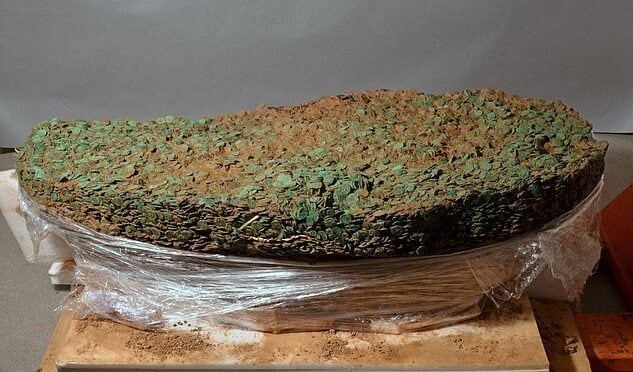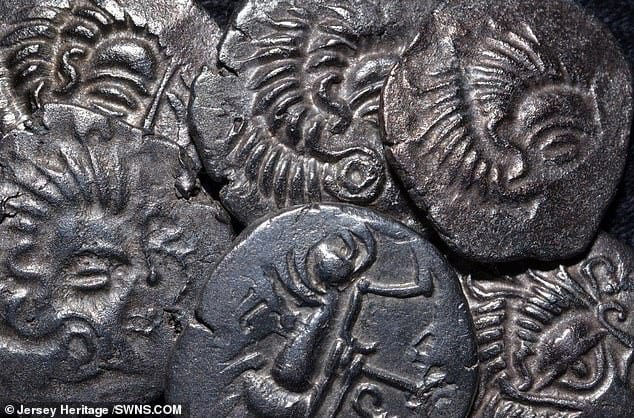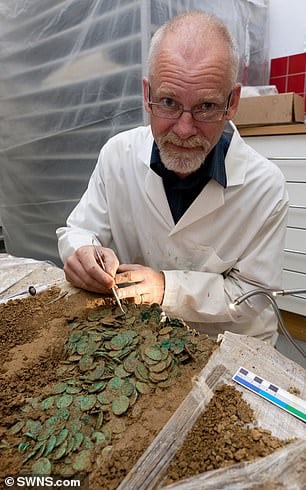Hustý
For 30 years, they believed the story that led them to the record-breaking discovery of hundreds of millions of coins
Categories: Minting - Numismatics , Finds and rescue research abroad , Nálezy nejenom s detektorem ve Velké Británii a Irsku

The huge, 750kg pile of coins from the 2012 discovery by detectorists Reg Mead and Richard Miles was recently recognised as a new world record for the number of coins in a single Iron Age assemblage. With a total of 69,347 Roman and Celtic coins, the depot surpassed the 42-year-old find of 54,951 coins in Wiltshire.
The silver coins date from between 50-30 BC. Back in 2012, their market value was estimated at £10 million, but this was later increased when gold and silver coins were also found at the centre of the huge assemblagesilver bracelets, glass beads or a gold-laced bag containing gold and silver jewellery, rings, coins and numerous precious metal fragments.
According to Mr Miles' account, the coins were not found by chance. In fact, in the 1980s, they received information from a woman who described strange "silver buttons" she had once seen in a field after a rain. It took 30 years before the friends actually found the source of the "buttons". Hidden on a farm in Grouville under a hedge a metre deep, they formed a large coin "blind".which was subsequently recovered with the surrounding soil in one block for examination under laboratory conditions.
"There was something that kept attracting us. We tried it every Sunday," Mr Miles recounted. "When I finally found the first coin, by the end of that day we had 20 in total." As the number of coins grew, they dug deeper and deeper. When they got to the depth of a whole spade, they hit something hard: "Did you hear that metal strike?"
The two men were there for the entire process, from discovery, announcement and retrieval, to preservation and media coverage, to entry into the Guinness Book of World Records. They also agree that participating and being involved in the whole process has been a truly wonderful experience for them.
"We are not surprised by this achievement and are delighted that such an impressive archaeological object has been discovered, researched and displayed in Jersey," said Olga Finch, Curator of Archaeology at Jersey Heritage Museum. "Once again this puts our island at the heart of international research into Iron Age coins and highlights the significant world heritage that Jersey has to offer."
There are so many coins in the find that it took almost five years to dismantle and catalogue the entire pile. The location of each individual coin and each of the objects in the assemblage were carefully recorded by scanner during the extraction process. This created a perfectly accurate 3D model for further research. The conservation of the coins has still not been completed.
The previous largest set of coins was discovered in 1978 in the former Roman town of Cunetio near Mildenhall. The depot contained 54,951 low-denomination copper coins minted in the 3rd century BC. The largest coin collection in the world was discovered in Brussels in 1908, when 150,000 medieval silver pennies from the 13th century were found.
Video






Roman Nemec
Sources: bbc.com, telegraph.co.uk
The article is included in categories:
- Archive of articles > Minting - Numismatics
- Archive of articles > Archaeology > Finds and rescue research abroad
- Archive of articles > Archaeology > Finds and rescue research abroad > Nálezy nejenom s detektorem ve Velké Británii a Irsku
Post
Mazec, pěkný koláč.
To je kujva slepenec 

Tak tohle bych chtěl zpracovávat asi by mi u toho furt stál :)
do katalogu jednotlivě a nefotit v ruce 
To je sen 
No...hustý. To bych nechtěl mít doma v polštáři 
Tak to je něco, a tady se dral do televize hledač co našel 50 stribrnejch koleček 


Neuvěřitelný nález, trpělivost se vyplatila. Za 5 let to celé naskenovat, rozebrat a vyčistit je taky slušnej výkon.
Hmmmm,pěkný slepenec 
Parádny a slávny nález...a super článok. 
...ale (keďže som rýpal a detailista), malú korekciu Romanovi urobím:
"Předchozí největší soubor mincí byl objeven v roce 1978 v bývalém římském městě Cunetio poblíž Mildenhallu. Depot obsahoval 54 951 měděných mincí nízkých nominálů ražených ve 3. století před naším letopočtem.".....v tomto citáte treba škrtnúť posledné 3 slová - išlo o nález z pol. 3. stor. n.l., väčšinou skoro medené antoniniany okolo Galliena a Postuma... 
Kelt: A jejda, máš pravdu! Anglický zdroj z BBC to sice uvádí před Kristem, ale mělo mě to trknout. Díky za Tvůj postřeh a doplnění, já se omlouvám za chybu.
Pěkný článek, zajímalo by mě jak se vyplatí nálezce, jestli se třeba část souboru prodá v nějakém aukčním domě, rád bych si taky na kolečko z tohohle nálezu přihodil.
Zpravidla to bývá tak, že koroner po posouzení znalci stanoví výši odměny. Tu si dělí nálezci s majitelem pozemku a přednost dostanou muzea (především to v daném kraji). Teprve v případě, kdyby nějaké muzeum zájem neprojevilo, mohlo by to za opět předem stanovených podmínek jít do soukromé aukce, ale to se určitě nestane. Muzeum si musí část financovat vlastními zdroji (např. sbírkou), ale zbytek dostane zcela jistě od národního loterijního fondu, který je pro tyto účely vytvořen - jde tam část zisků z loterie. Opravdu dobře vymyšlený systém.
To je pro nás sen škoda 




















